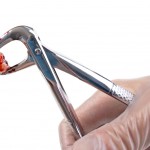
Alveolar osteitis (dry socket) is a common complication following permanent tooth extraction. The incidence of alveolar osteitis (AO) has been reported to range from 0.5-68% and is considered to be up to 10 times more common following the removal of lower third molars.
The aim of this review was to assess the effect of chlorhexidine (CHX) gel on the incidence of alveolar osteitis (AO)
Methods
Searches were conducted in the Medline, Cochrane Central, Scopus and Google Scholar databases for English language papers published after 2010. Randomised controlled trials (RCTs) of the effectiveness of CHX gel for the prevention of AO incidence in mandibular third molar extraction published in English were considered. Initial study selection was carried out by a single reviewer with two independent reviewers carrying out a second stage assessment.
The Cochrane tool was used to assess risk of bias and a random effects meta-analysis conducted Sub-group analysis for smoking, oral contraceptive use and split mouth studies was carried out.
Results
- 10 RCTs involving a total of 862 patients were included
- 3 RCTs were split mouth studies
- 3 RCTs were considered to be at high risk of bias
- Meta-analysis (10 studies) found a CHX gel reduced the incidence of AO by 57% Risk ratio (RR) = 0.43- (95%CI; 0.32 – 0.58)
- Meta-analysis (4 studies) suggests a smaller reduction in AO incidence (40%) RR= 0.60 (95%CI; 0.41 – 0.87) in smokers and those using oral contraceptives.
Conclusions
The authors concluded: –
This systematic review and meta-analysis provide clinically significant evidence that CHX gel application in the extraction socket of mandibular third molar has reduced the incidence of AO.
Comments
Early this year we commented on a review by Rodríguez-Sánchez et al assessing the effects of CHX gel and rinse on AO (Dental Elf -13th Mar 2017) and noted the 2012 Cochrane review by Daley et al (Dental Elf -13th Dec 2012). This new review focuses on CHX gels only. The review has searched for a restricted time period and limited studies to those published in English so relevant studies will not have been included. The Rodríguez-Sánchez review also included 10 studies on the effects of CHX gels however only 5 studies are common to both reviews although the risk ratio very similar, RR = 0.47; (95%CI; 0.37- 0.60).
As with the previous reviews on this topic a beneficial effect on AO is see with the use of CHX gel. However, there remain a limited number of small studies available and little data on adverse effects. In addition it is worth highlighting that two serious adverse events associated with irrigation of dry socket with chlorhexidine mouthrinse have been reported in the UK.
Links
Primary paper
Teshome A. The efficacy of chlorhexidine gel in the prevention of alveolar osteitis after mandibular third molar extraction: a systematic review and meta-analysis. BMC Oral Health BMC series – open, inclusive and trusted 2017 17:82 DOI: 10.1186/s12903-017-0376-3
Other references
Dental Elf – 13th Mar
https://www.nationalelfservice.net/dentistry/oral-and-maxillofacial-surgery/chlorhexidine-gels-rinses-reduce-dry-socket-third-molar-extraction/
Dental Elf – 13th Dec 2012
Some limited evidence to support the use of chlorhexidine to prevent dry socket
